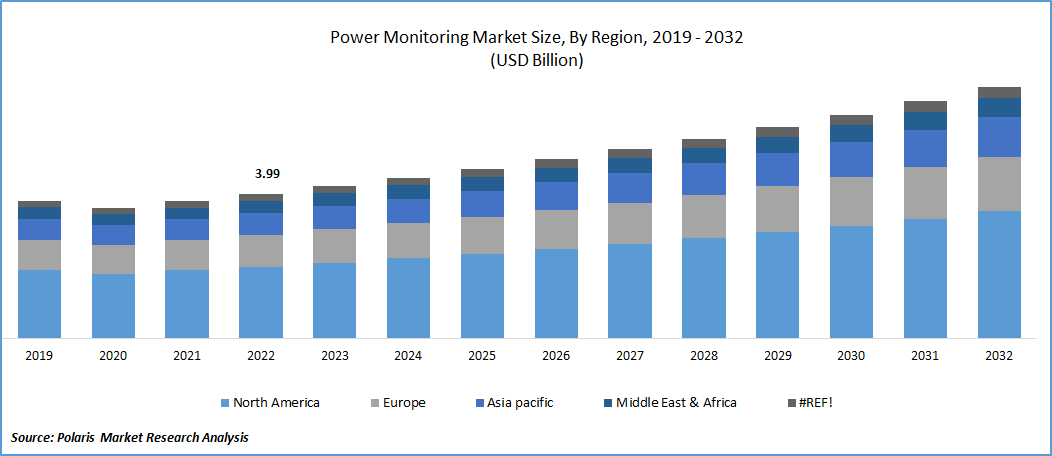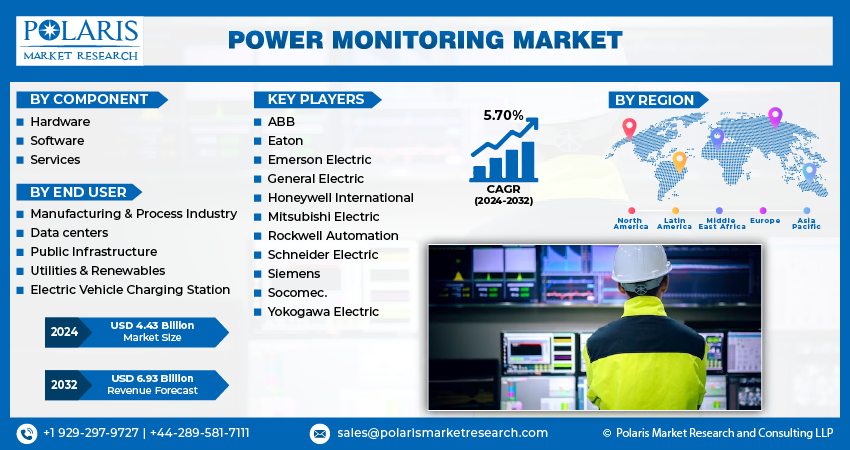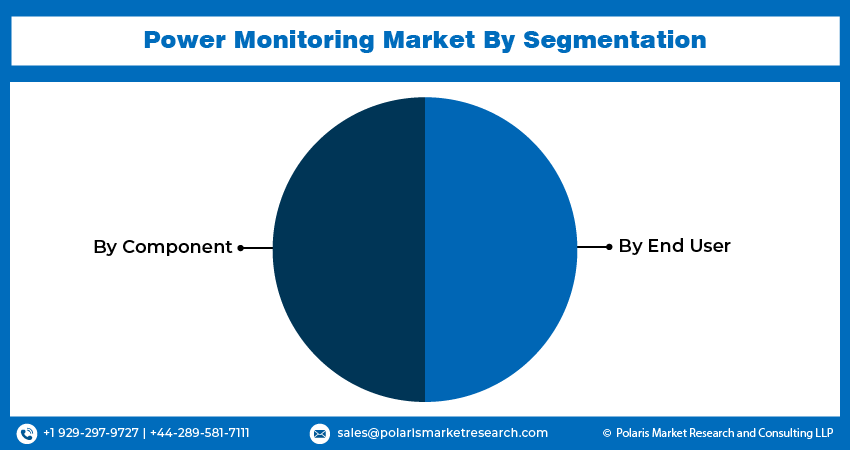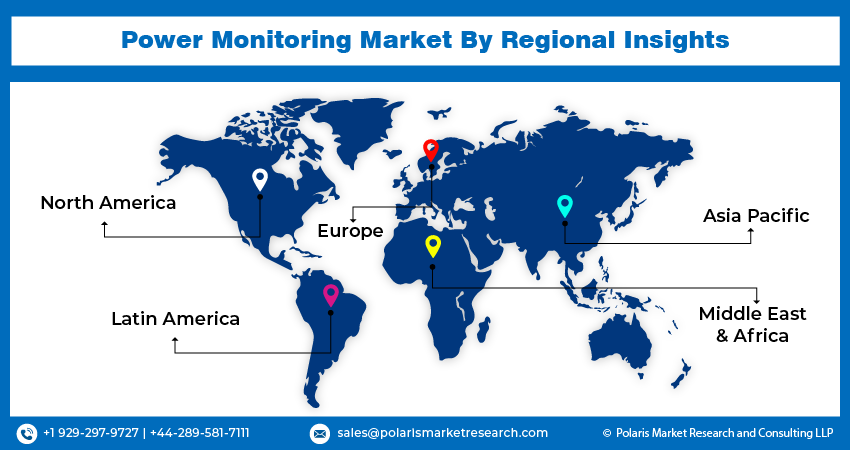
Power Monitoring Market Share, Size, Trends, Industry Analysis Report, By Component (Hardware, Software, Services); By End User; By Region; Segment Forecast, 2024 - 2032
- Published Date:Jan-2024
- Pages: 117
- Format: PDF
- Report ID: PM3688
- Base Year: 2023
- Historical Data: 2019-2022
Report Outlook
The global power monitoring market was valued at USD 4.21 billion in 2023 and is expected to grow at a CAGR of 5.70% during the forecast period.
Market is experiencing significant growth due to several factors. One of the key drivers is the rising prosperity & continuously expanding commercial activity worldwide, which has led to a around 15 percent increase in the energy demand. Additionally, the strong growth of the middle class in developing nations has contributed to a surge in energy demand of about 35%. Moreover, there is a growing emphasis on improving building efficiencies in developed countries, resulting in a projected reduction of energy demand by approximately 15%, by 2050.

To Understand More About this Research: Request a Free Sample Report
This shift towards energy-efficient practices is driven by the need to address environmental concerns and promote sustainability. Furthermore, the global demand for electricity is on the rise, with an annual growth rate of 1.8%. It is estimated that electricity will constitute almost 50% of the energy sector by 2050, as there is a decline in the demand for traditional biomass, coal, and oil. This shift towards electricity as a primary energy source creates a need for effective power monitoring systems to ensure efficient distribution and utilization of electricity.
Industry Dynamics
Growth Drivers
Increasing adoption of the Internet of Things (IoT) in office automation systems
The growth of the power monitoring market is being driven by various factors, including the increasing adoption of the Internet of Things (IoT) in office automation systems. The IoT enables the monitoring of electrical appliances and sensor data, creating an interconnected network that enhances power monitoring capabilities. Recent study focused on the internet of things-based on real-time data monitoring framework for predictive maintenance. This necessitates ongoing research and development efforts. These activities focus on enhancing the performance, reliability, and scalability of the monitoring systems.
Researchers and developers work towards refining algorithms, optimizing data analysis techniques, and exploring novel approaches to predictive maintenance. These technological advancements are a direct result of market research and development activities.

Report Segmentation
The market is primarily segmented based on component, end user and region.
|
By Component |
By End User |
By Region |
|
|
|
To Understand the Scope of this Report: Speak to Analyst
By Component Analysis
Software segment is projected to experience faster growth in the study period
Software segment is expected to have faster growth for the market. Power monitoring software offers sophisticated analytics capabilities, allowing businesses to process and analyze large volumes of data collected from power monitoring devices. These software solutions enable real-time monitoring, data visualization, and reporting, providing valuable insights into energy consumption patterns, power quality, and equipment performance. The ability to extract actionable information from data drives the demand for power monitoring software.
This plays a crucial role in energy management and optimization efforts. It allows organizations to monitor energy consumption in real-time, identify inefficiencies, and implement energy-saving measures. Advanced software solutions offer features like load profiling, demand response, and energy benchmarking, enabling businesses to optimize their energy usage and reduce costs. The focus on energy efficiency and cost savings drives the adoption of power monitoring software.
Power monitoring software often includes remote monitoring and control capabilities, allowing users to access and manage power data from anywhere. This remote accessibility is particularly beneficial for large-scale operations or organizations with multiple sites. Software solutions enable centralized monitoring, control, and management of power systems, enhancing operational efficiency and reducing the need for on-site maintenance. The convenience and efficiency offered by remote monitoring contribute to the growth of power monitoring software.
By End User Analysis
Utilities & Renewables segment accounted for the largest market share in 2022
Utilities & Renewables segment holds the largest market share for the market in the study period. This is at the forefront of integrating renewable energy sources, such as solar and wind, into the power grid. Power monitoring systems are crucial for effectively managing the integration of renewable energy by monitoring the generation, distribution, and utilization of renewable power. These systems enable utilities to track the performance of renewable energy assets, optimize their output, and balance supply and demand in real-time. The need for efficient integration and management of renewable energy sources drives the demand for advanced power monitoring solutions.
This segment is increasingly embracing smart grid technologies to enhance grid efficiency, reliability, and resilience. Power monitoring is a critical component of smart grid infrastructure, enabling utilities to gather real-time data, monitor power flows, and optimize grid operations. Power monitoring systems are essential for implementing advanced grid management strategies, such as predictive maintenance, fault detection, and outage management. As the adoption of smart grid solutions continues to grow, the demand for power monitoring systems in the Utilities & Renewables segment expands accordingly.

Regional Insights
Asia Pacific registered with the highest growth rate in the study period
APAC is projected to witness a higher growth rate for the market. This region is being strongly driven by ambitious renewable energy plans and targets set by countries like China, India, and Indonesia. China has set a target to increase its renewable power capacity to over half of the total installed capacity by 2025. This commitment to renewable energy necessitates effective power monitoring systems to efficiently integrate and manage renewable sources like solar and wind power. The scale of China's renewable energy plans creates a significant demand for power monitoring solutions, fostering market growth.
India has set even more ambitious goals, aiming to achieve over half of its total installed capacity from renewable sources by 2030. This commitment to renewable energy deployment creates a substantial demand for power monitoring technologies to optimize the integration, distribution, and management of renewable power. The Indian market's focus on renewable energy significantly contributes to the growth of the market in the region.
Indonesia has set a target to add 41 GW of power capacity in coming years, with a notable emphasis on renewable energy sources. This represents a significant shift, as renewable energy will make up most of the installed capacity. The integration of renewable power sources requires efficient power monitoring systems to ensure grid stability and optimal utilization, thereby driving the demand for power monitoring solutions in the Indonesian market in turn Asia Pacific.
North America garnered with the larger revenue share in the forecast time frame
North America is expected to witness a larger revenue share for the market. This region is actively pursuing smart grid initiatives to modernize the aging power infrastructure. Smart grids incorporate advanced technologies, including power monitoring systems, to enable real-time monitoring, control, and optimization of power generation, transmission, and distribution. The deployment of power monitoring solutions is a crucial component of smart grid initiatives, driving the growth of the region.
The market in this region is experiencing significant growth due to the US Department of Energy's (DOE) efforts to enhance the country's electricity grid. The DOE has announced a $10.5 billion program aimed at smart grid initiatives and other grid upgrades to strengthen the power infrastructure. The emphasis on smart grids highlights the importance of advanced power monitoring systems to enable real-time monitoring, control, and optimization of power generation, transmission, and distribution. This will further create new growth potential for the power monitoring market in this region in coming years.

Key Market Players & Competitive Insight
Key players in the market are constantly upgrading their technologies to stay ahead of the competition and to ensure efficiency, integrity, and safety. These players focus on partnership, product upgrades, and collaboration to gain a competitive edge over their peers and capture a significant market share.
Some of the major players operating in the global market include:
- ABB
- Eaton
- Emerson Electric
- General Electric
- Honeywell International
- Mitsubishi Electric
- Rockwell Automation
- Schneider Electric
- Siemens
- Socomec.
- Yokogawa Electric
Recent Developments
- In June 2023, ABB acquired Eve Systems, a prominent smart home products company headquartered in Munich. With operations in Europe and the United States, Eve Systems specializes in offering innovative smart home solutions.
- In May 2023, Siemens announced its plans to acquire the EV division of Mass-Tech Controls, a move that will significantly expand its eMobility offering in India. This acquisition is driven by the increasing demand for electric vehicle charging infrastructure in the country.
Power Monitoring Market Report Scope
|
Report Attributes |
Details |
|
Market size value in 2024 |
USD 4.43 billion |
|
Revenue forecast in 2032 |
USD 6.93 billion |
|
CAGR |
5.70% from 2024 - 2032 |
|
Base year |
2023 |
|
Historical data |
2019 - 2022 |
|
Forecast period |
2024 - 2032 |
|
Quantitative units |
Revenue in USD billion and CAGR from 2024 to 2032 |
|
Segments covered |
By Component, By End User, By Region |
|
Regional scope |
North America, Europe, Asia Pacific, Latin America, Middle East & Africa |
|
Customization |
Report customization as per your requirements with respect to countries, region and segmentation |
FAQ's
The global power monitoring market size is expected to reach USD 6.93 billion by 2032
Top key market players in the market ABB,Eaton,Emerson Electric,General Electric,Honeywell,International,Mitsubishi Electric.
North America region contribute notably towards the global power monitoring market.
The global power monitoring market is expected to grow at a CAGR of 5.7% during the forecast period.
The power monitoring market report covering key segments are component, end user and region.
